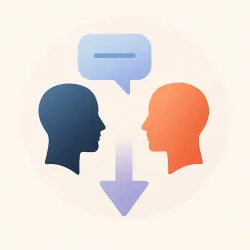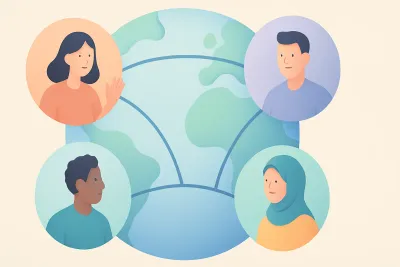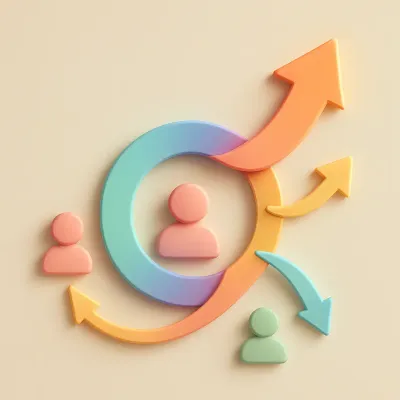Introduction: The Hidden Foundation of Performance
When a new employee joins your team, you focus on their skills and knowledge. You train them on systems, processes, and technical competencies. You measure their progress through certifications, assessments, and performance metrics. But you're optimizing for the wrong variables.
The skills and knowledge that make someone a capable team member don't come from training sessions and video materials. They come from people—specifically, from the relationships that enable informal learning, knowledge transfer, and the kind of contextual understanding that no handbook can provide.
This isn't just intuition. It's measurable, quantifiable, and supported by decades of behavioral science research. Yet most organizations continue to treat relationship building as a nice-to-have rather than the fundamental infrastructure that determines whether people succeed or struggle from day one.
The consequence? We're creating vastly unequal experiences where some employees thrive because they accidentally land in teams with strong social fabric, while others are set up to fail despite having identical technical qualifications.
The New Relationship Reality: Why Connection Is Harder Than Ever
The Digital Divide in Human Connection
Relationships in the workplace are harder to build than they've ever been. The shift to digital, hybrid, and remote work has fundamentally altered how human connections form and develop. What once happened naturally through proximity and spontaneous interaction now requires deliberate design and systematic support.
Microsoft's comprehensive study of 61,182 employees revealed the scope of this challenge. Remote work caused collaboration networks to become 25% more static and siloed, with cross-functional relationships declining significantly (Yang et al., 2022). The research showed that while the volume of digital communication increased—Teams meetings more than doubled and chat messages rose 45%—the quality and breadth of professional relationships actually decreased.
This isn't simply about working from home. It's about the fundamental shift from relationship formation through proximity to relationship formation through intention. In traditional office environments, relationships developed through what researchers call "weak ties"—casual interactions that happened naturally through shared physical spaces. Remote and hybrid work environments eliminate many of these touchpoints, requiring organizations to recreate them systematically.
The Emotional Intelligence Fallback
Faced with these challenges, many organizations default to what seems like an obvious solution: hire people with higher emotional intelligence and train existing employees to be better at relationships. The logic appears sound—if building relationships is harder, we need people who are naturally better at it.
The data tells a different story. Research at Happily.ai analyzing real workplace interactions found that only 6.4% of people demonstrate high emotional intelligence consistently in workplace settings (Happily.ai, 2023). This means that 93.6% of your workforce—regardless of their technical competence—may struggle to build the relationships that research shows are critical for performance.
More concerning is what this approach creates: a system where workplace success becomes contingent on exceptional interpersonal skills rather than the ability to do the actual job. This creates inherent inequity, where employees with identical technical qualifications have vastly different experiences based on their natural relationship-building abilities.
The Compounding Effect of Relationship Inequality
The impact of this relationship divide compounds over time. Employees who successfully build early workplace relationships gain access to informal mentoring, knowledge networks, and career opportunities. Those who struggle remain isolated from the very systems that could help them develop both professionally and personally.
Research shows that employees with zero meaningful workplace connections have the highest exit rates, while each additional reciprocated relationship reduces turnover risk by approximately 40% (Happily.ai research, 2024). Critically, the relationship between job tenure and meaningful connections isn't strongly correlated—meaning time alone doesn't build relationships. Intentional systems do.
The Science of Relationship-Driven Performance
Google's Breakthrough: Relationships Over Talent
Google's Project Aristotle provides the most comprehensive evidence for why relationships matter more than individual capabilities. After studying 180 teams and analyzing over 250 different team attributes, Google discovered that team composition—the specific mix of skills, personalities, and backgrounds—had virtually no correlation with team effectiveness.
Instead, psychological safety—the quality of relationships where people feel safe to take risks, ask questions, and be vulnerable with each other—emerged as the strongest predictor of team success (Rozovsky, 2015). Teams with high psychological safety showed 31% more innovation and 19% higher productivity than teams lacking these relationship foundations.
This finding challenged fundamental assumptions about talent management. The prevailing wisdom suggested that assembling the best individual performers would create the best teams. Project Aristotle proved that how team members interact matters far more than who they are.
The Mechanisms Behind Relationship-Driven Performance
Understanding why relationships drive performance requires examining the specific mechanisms through which human connection translates to business outcomes:
Information Flow and Knowledge Transfer Strong workplace relationships create efficient channels for information sharing. In teams with high trust and frequent interaction, knowledge moves quickly and accurately. Critical insights reach the right people faster, problems are identified earlier, and solutions are shared more effectively.
MIT's Human Dynamics Laboratory quantified this effect, finding that communication patterns alone could predict 35% of team performance variations. When team members had regular, high-quality exchanges, their collective output improved dramatically—not because individuals became more capable, but because the team became more intelligent as a system.
Error Detection and Learning Psychological safety enables teams to acknowledge and learn from mistakes rather than hiding them. In high-trust environments, errors become learning opportunities rather than sources of blame. This creates faster feedback loops and continuous improvement.
Research consistently shows that teams with strong relationships report errors more frequently and resolve them more quickly. This isn't because they make more mistakes—it's because they create environments where problems surface before they become crises.
Creative Collaboration and Innovation Innovation requires the kind of risk-taking and experimentation that only happens when people feel safe to propose ideas that might fail. Teams with strong relationship foundations are more likely to engage in the productive conflict and creative tension that drives breakthrough thinking.
Studies of high-performing creative teams consistently find that relationship quality, not individual talent, predicts innovative output. When team members trust each other enough to challenge ideas constructively, the collective creative capacity exceeds what any individual could achieve alone.
The Network Effects of Workplace Relationships
Individual relationships don't exist in isolation—they form networks that create emergent properties at the organizational level. Research on workplace social networks reveals how relationship patterns shape everything from employee engagement to organizational agility.
Organizations with dense, cross-functional relationship networks adapt more quickly to change, share knowledge more effectively, and maintain higher levels of employee satisfaction. Conversely, organizations with fragmented relationship patterns struggle with coordination, duplicate efforts, and lose institutional knowledge when key individuals leave.
The network effect explains why some organizations seem to consistently outperform others despite having similar talent and resources. It's not about having better people—it's about having better systems for connecting people.
The Learning Revolution: How Knowledge Actually Transfers
The 70:20:10 Reality
The Center for Creative Leadership's research revealed a fundamental truth about how people actually develop professionally: 70% of learning occurs informally through on-the-job experiences and relationships, 20% happens through feedback and coaching from others, and only 10% comes from formal training programs.
This finding has been replicated across industries and cultures, yet most organizational learning and development investments remain inverted. Companies typically spend 80% of their L&D budgets on formal training and only 20% on supporting the informal learning that research shows drives the vast majority of professional development.
The Relationship Learning Advantage
Informal learning through relationships offers several advantages over formal training:
Contextual Relevance Learning from colleagues happens in real work contexts, making it immediately applicable. Unlike classroom training that requires translation to actual work situations, relationship-based learning is already embedded in the specific challenges and nuances of your organization.
Just-in-Time Delivery Peer learning occurs when people need it most—in the moment they're facing a specific challenge or opportunity. This timing advantage dramatically improves both retention and application compared to scheduled training that may not align with immediate needs.
Customized to Individual Needs Colleagues can adapt their teaching to individual learning styles, backgrounds, and current skill levels in ways that standardized training cannot. This personalization increases both engagement and effectiveness.
Trust-Mediated Transfer When learning comes from trusted relationships, people are more likely to apply it. The social connection creates accountability and ongoing support that formal training typically lacks.
The Compound Effect of Relationship Learning
Organizations that successfully support informal learning through relationships create compound advantages. As knowledge spreads through network connections, the collective intelligence of the organization increases exponentially. Individual improvements multiply across teams, creating organizational capabilities that exceed the sum of individual skills.
This explains why some companies seem to consistently develop talent more effectively than others. It's not their formal training programs—it's their relationship infrastructure that enables continuous, peer-to-peer knowledge transfer.
The Onboarding Paradox: Skills vs. Relationships
The Current State of New Employee Integration
Most onboarding processes reflect a fundamental misunderstanding of how people actually become productive team members. Organizations typically focus 80-90% of onboarding time on systems training, compliance requirements, and role-specific skill development. Relationship building, when it happens at all, is treated as a secondary consideration.
This approach produces predictable results. Traditional skills-focused onboarding leaves 71% of employees feeling unprepared to excel in their roles, while 22% of staff turnover occurs within the first 45 days due to poor social integration.
The Relationship-Focused Alternative
Organizations that implement relationship-focused onboarding see dramatically different outcomes: 82% improvement in retention rates and 69% of employees staying for a minimum of three years (Brandon Hall Group, 2017). The difference lies in prioritizing social integration alongside functional training.
Effective relationship-focused onboarding includes:
Structured Mentoring Programs Pairing new employees with experienced colleagues who can provide ongoing guidance, context, and informal learning opportunities. These relationships often become the primary source of job-related knowledge transfer.
Cross-Functional Exposure Creating opportunities for new hires to meet and work with people across different departments, building the broad relationship network that enables future collaboration and career development.
Cultural Integration Activities Helping new employees understand not just what to do, but how things get done in the specific organizational context. This cultural knowledge is almost always transmitted through relationships rather than formal training.
Early Project Collaboration Assigning new hires to collaborative projects where they can contribute while building working relationships with team members. This creates immediate value while establishing the social connections that enable long-term success.
The Long-Term Impact of Relationship-Centered Onboarding
Employees who build strong relationships during onboarding don't just stay longer—they perform better throughout their tenure. They have access to informal mentoring, they understand organizational dynamics more quickly, and they're more likely to receive opportunities for advancement.
Perhaps most importantly, they become relationship builders themselves, creating a positive cycle where strong social fabric attracts and develops more people who contribute to relationship quality.
Communication Patterns: The Hidden Architecture of Culture
Beyond Individual Communication Skills
Most organizations approach communication improvement by training individuals to be better communicators. While communication skills matter, this individual-focused approach misses the larger opportunity: designing communication patterns at the system level.
Research from MIT's Human Dynamics Laboratory found that communication patterns during work are the most important predictor of team success—more significant than individual intelligence, personality, and skills combined. The study identified three critical dimensions:
Energy: The number and quality of exchanges between team members. Teams with more frequent, substantive interactions consistently outperformed those with sporadic communication.
Engagement: How evenly communication is distributed across team members. Teams where everyone contributes roughly equally make better decisions than those dominated by a few voices.
Exploration: How much teams communicate with people outside their immediate group. This external connection prevents groupthink and brings in fresh perspectives.
Designing Communication Infrastructure
Organizations that understand these patterns can design communication infrastructure that promotes high performance regardless of individual communication skills:
Structured Interaction Opportunities Creating regular touchpoints that encourage substantive exchanges. This might include brief daily check-ins, weekly cross-functional updates, or monthly problem-solving sessions.
Balanced Participation Systems Implementing meeting structures and decision-making processes that ensure everyone contributes. This might involve round-robin discussions, anonymous input systems, or rotating leadership roles.
Cross-Boundary Connection Points Establishing formal and informal ways for teams to interact with other parts of the organization. This could include cross-functional projects, internal conferences, or structured knowledge-sharing sessions.
The Multiplication Effect of System-Level Communication Design
When communication patterns are designed at the system level, individual limitations matter less. People who might struggle to build relationships naturally are supported by structures that create interaction opportunities. Meanwhile, naturally gifted communicators can focus their energy on high-value activities rather than compensating for system failures.
This approach creates more equitable outcomes while improving overall organizational performance.
Building Systematic Relationship Infrastructure
Moving Beyond Individual Solutions
The evidence overwhelmingly shows that workplace success depends more on relationship quality than individual capabilities. Yet most organizations continue to treat relationship building as an individual responsibility rather than a system design challenge.
This approach is both ineffective and inequitable. It places the burden of workplace success on personal emotional intelligence rather than creating environments where healthy relationships can develop naturally. It also creates dramatic variations in employee experience based on the accident of team assignment rather than organizational design.
The Elements of Relationship Infrastructure
Organizations that successfully support relationship development implement multiple, reinforcing systems:
Relationship-Integrated Onboarding New employee programs that prioritize social integration alongside skill development, including structured mentoring, cross-functional exposure, and early collaborative projects.
Communication Pattern Design Meeting structures, feedback systems, and collaboration processes designed to promote high-quality interactions and balanced participation.
Cross-Functional Connection Systems Regular opportunities for people to work with colleagues outside their immediate team, building the broad networks that enable organizational agility.
Relationship Measurement and Accountability Tracking relationship quality and network health as seriously as other business metrics, with clear accountability for managers to support team relationship development.
Recognition and Reward Alignment Acknowledgment systems that reinforce relationship-building behaviors and collaborative success, not just individual achievement.
Implementation Strategies
Building relationship infrastructure requires systematic implementation across multiple organizational levels:
Leadership Modeling Senior leaders must demonstrate the behaviors and priorities they want to see throughout the organization. This includes investing time in relationship building and making it a visible priority.
Manager Development Training and supporting managers to facilitate relationship development within their teams. This includes skills for creating psychological safety, facilitating effective communication, and supporting cross-functional collaboration.
Process Integration Embedding relationship considerations into existing business processes rather than treating them as separate initiatives. This might include adding relationship elements to project planning, performance reviews, and strategic planning.
Technology Support Using collaboration platforms, networking tools, and communication systems that facilitate rather than hinder relationship development.
Measurement and Iteration Regularly assessing relationship quality and network health, using data to identify areas for improvement and track progress over time.
The Business Case for Relationship Infrastructure
Quantifiable Returns on Relationship Investment
Organizations that invest in relationship infrastructure see measurable returns across multiple business metrics:
Retention Improvements Companies with strong relationship systems report 23% higher retention rates and 52% better performance in keeping valued employees.
Performance Gains Teams with quality relationships show 70% productivity improvements and 2.8 times more innovation compared to teams with poor relationship dynamics.
Recruitment Advantages Organizations known for strong workplace relationships attract better talent and see higher acceptance rates for job offers.
Customer Impact There's a direct correlation between employee relationship quality and customer satisfaction, as engaged employees provide better service and create more positive customer experiences.
The Cost of Relationship Infrastructure Failure
The absence of relationship infrastructure creates hidden costs that compound over time:
Turnover Expenses The cost of losing an employee ranges from 50% of annual salary for entry-level positions to 200% for senior leaders when including recruiting, onboarding, and productivity losses.
Performance Gaps Teams with poor relationships consistently underperform, creating opportunity costs that are difficult to quantify but substantial in impact.
Innovation Limitations Organizations with weak relationship networks struggle to share knowledge, coordinate efforts, and generate breakthrough ideas.
Cultural Degradation Poor relationship infrastructure creates negative cycles where talented people leave, further weakening the social fabric and making it harder to attract replacements.
Implementation Framework: From Strategy to Practice
Phase 1: Assessment and Foundation Building
Relationship Network Analysis Map current relationship patterns within the organization to identify strengths, gaps, and opportunities. This includes formal reporting relationships as well as informal collaboration networks.
Communication Pattern Evaluation Assess how information flows through the organization, where communication breaks down, and what barriers prevent effective interaction.
Cultural Baseline Measurement Establish metrics for relationship quality, psychological safety, and employee satisfaction to track progress over time.
Phase 2: System Design and Pilot Implementation
Onboarding Program Redesign Implement relationship-focused onboarding for new hires, including structured mentoring, cross-functional exposure, and early collaborative projects.
Communication Infrastructure Development Design meeting structures, feedback systems, and collaboration processes that promote high-quality interactions and balanced participation.
Manager Training and Support Develop managers' capabilities to facilitate relationship development, create psychological safety, and support cross-functional collaboration.
Phase 3: Scaling and Integration
Process Integration Embed relationship considerations into existing business processes, performance management systems, and strategic planning activities.
Technology Implementation Deploy collaboration platforms and communication tools that facilitate relationship development and knowledge sharing.
Recognition System Alignment Modify recognition and reward systems to reinforce relationship-building behaviors and collaborative success.
Phase 4: Measurement and Optimization
Continuous Assessment Regularly measure relationship quality, network health, and employee satisfaction to identify areas for improvement.
Data-Driven Iteration Use relationship and performance data to refine systems, address gaps, and optimize outcomes.
Cultural Evolution Support the natural evolution of organizational culture as relationship infrastructure becomes embedded in daily operations.
The Future of Work: Relationship-Centered Organizations
Beyond the Individual Performance Model
The traditional model of workplace success—hire talented individuals, train them on necessary skills, and manage their performance—is fundamentally inadequate for modern organizational challenges. In an era of distributed work, rapid change, and complex collaboration requirements, individual capabilities matter less than collective intelligence.
Relationship-centered organizations represent the next evolution in organizational design. These organizations recognize that their competitive advantage comes not from having the best individuals, but from creating the best systems for connecting people, sharing knowledge, and enabling collective achievement.
The Compound Advantage
Organizations that successfully build relationship infrastructure create compound advantages that become increasingly difficult for competitors to replicate. As relationship quality improves, performance increases, which attracts better talent, which further strengthens relationships, creating a positive cycle of continuous improvement.
These advantages compound over time because relationship infrastructure becomes embedded in organizational culture. Unlike technical capabilities that can be copied or purchased, relationship systems are unique to each organization and take years to develop effectively.
Preparing for Distributed Work Realities
The future of work will be increasingly distributed, with teams collaborating across geographic, temporal, and organizational boundaries. Success in this environment requires intentionally designed relationship infrastructure that can function effectively regardless of physical proximity.
Organizations that develop this capability now will have substantial advantages as work continues to evolve. Those that continue to rely on proximity-based relationship formation will find themselves increasingly disadvantaged.
Conclusion: The Choice Before Us
The evidence is clear: workplace success depends more on relationship quality than individual capabilities. Organizations that recognize this reality and build systematic support for human connection don't just create better places to work—they dramatically outperform those still focused solely on individual talent management.
The choice before every organization is simple but profound: continue placing the burden of workplace relationship success on individual emotional intelligence, or build systems that make healthy communication patterns and strong relationships the organizational default.
This isn't just about employee satisfaction or workplace culture—it's about fundamental competitive advantage. In an economy where knowledge work dominates and collaboration requirements continue to increase, relationship infrastructure will become as critical as technical infrastructure.
The organizations that understand this and act on it now will create sustainable advantages that compound over time. Those that continue to treat relationship building as an individual responsibility rather than a system design challenge will find themselves increasingly unable to compete for talent, generate innovation, or achieve the kind of collaborative performance that modern business demands.
The skills and knowledge that make us successful come from the people we learn them from. It's time we built organizations that reflect this reality.
This research synthesis is based on studies from Google's Project Aristotle, MIT's Human Dynamics Laboratory, the Center for Creative Leadership, Microsoft's remote work research, Brandon Hall Group's onboarding studies, and proprietary research from Happily.ai's analysis of workplace relationships and communication patterns.









